The basilica de la Sagrada Familia has been one of those bucket list items for me. Ever since I first learned about it I knew it was something I needed to see in my life time. No trip to Barcelona would be complete without seeing Gaudí’s final masterpiece. Today I’m going to go over the history and future of the basilica along with tips for your visit.
Construction Begins
The church was commissioned by the Spiritual Association of Devotees of Saint Joseph. Francisco de Paula del Villar was the original architect on the project and had plans for a Gothic revival church. Construction began on the crypt in march of 1882 and was funded entirely by donations. Villar resigned the following year having only completed the crypt. Antoni Gaudí then took over work on the church and in 1884 was appointed Architect Director.
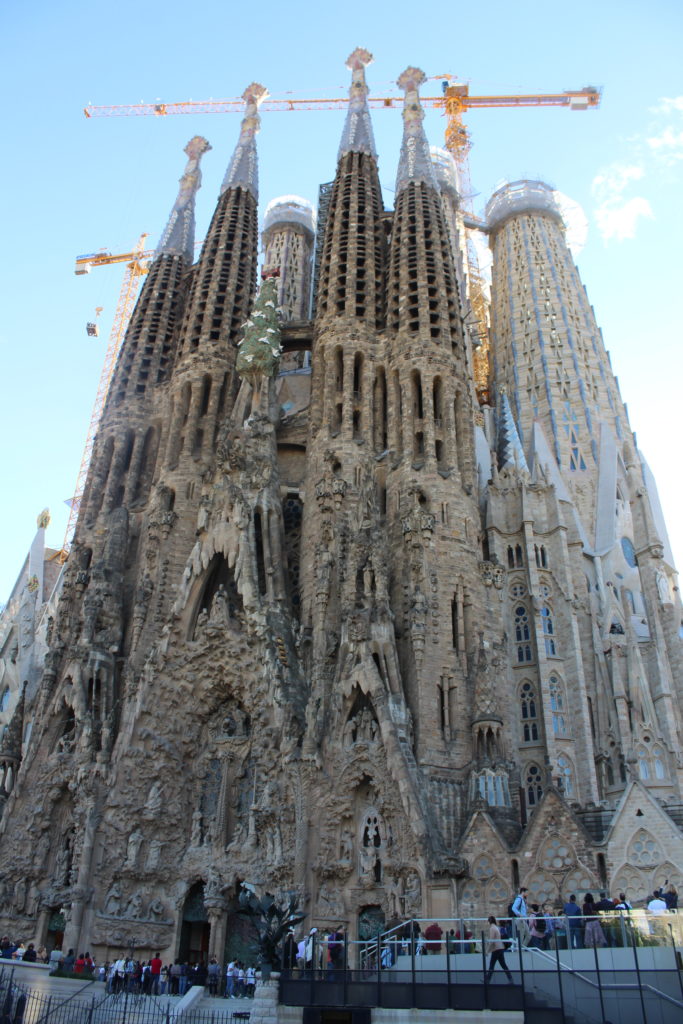
Gaudí’s Death
Unfortunately, on the morning of June 7, 1926 – while walking to morning prayer and confession – Gaudí was struck by a passing tram. Mistaken for a beggar by witnesses, he received only rudimentary care. He died in hospital a few days later on June 10th at the age of 73. Gaudí’s funeral was attended by thousands and the entire city mourned his death. His funeral procession snaked through the city and ended at the unfinished Sagrada Família where he was laid to rest in the crypt. At the time of his death the cathedral was between 15-25% done. Domènec Sugrañes i Gras took over the project after Gaudí’s death until construction was interrupted by the 1936 Spanish Civil War.
Post Civil War
Gaudí worked a lot with 3D plaster models for Sagrada Familia, versus the more traditional 2D blueprints of the time. Using these models helped him to analyze the feasibility of the structure and visualize architectural solutions. Gaudí’s workshop was destroyed by Catalan Anarchists during the civil war. Gaudí’s models of the church, and parts of the unfinished basilica were destroyed causing a setback in construction. Today’s plans for the basilica are based on modern adaptations and reconstructed plans, as the originals had been burned in a fire.
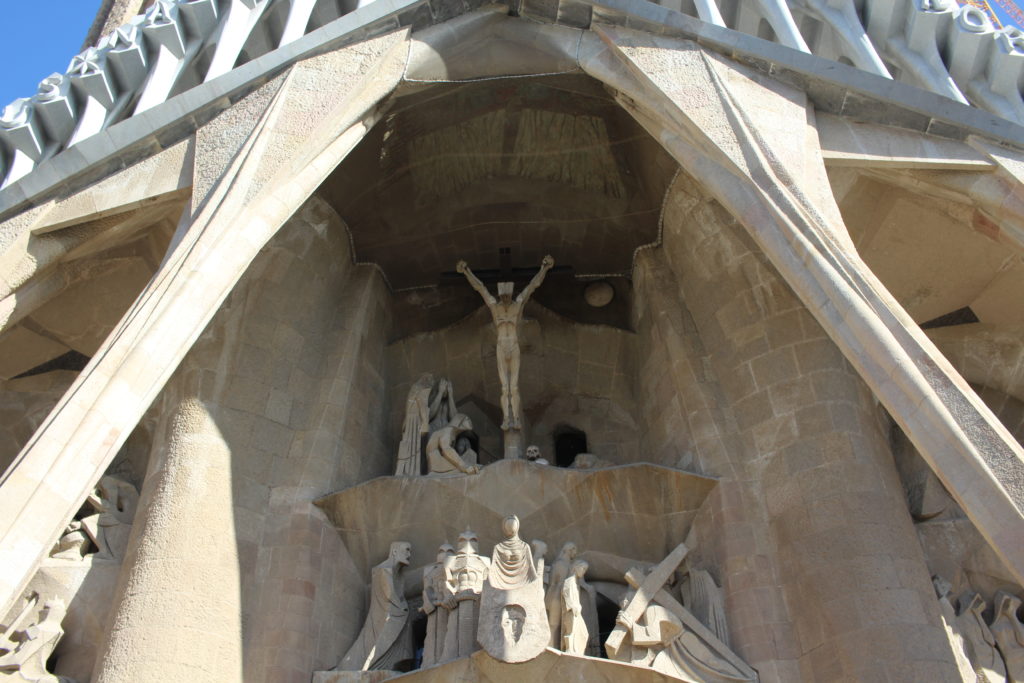
A Modern Approach
Since 1940, many architects and sculptors have contributed to the building of Sagrada Familia, each adding personal touches while also staying true to Gaudí’s original plan. Due to advances in technology, they’ve been able to speed up construction. Using computer-aided design means that stone no longer needs to be carved by hand onsite, but can be shaped by machines offsite. As of 2015, construction was 70 percent complete, and entering the final stages. The basilica is set to be completed in 2026, the 100th anniversary of Gaudí’s death. The unfinished church was consecrated on November 7, 2010 – by Pope Benedict XVI – allowing it to be used for religious services.
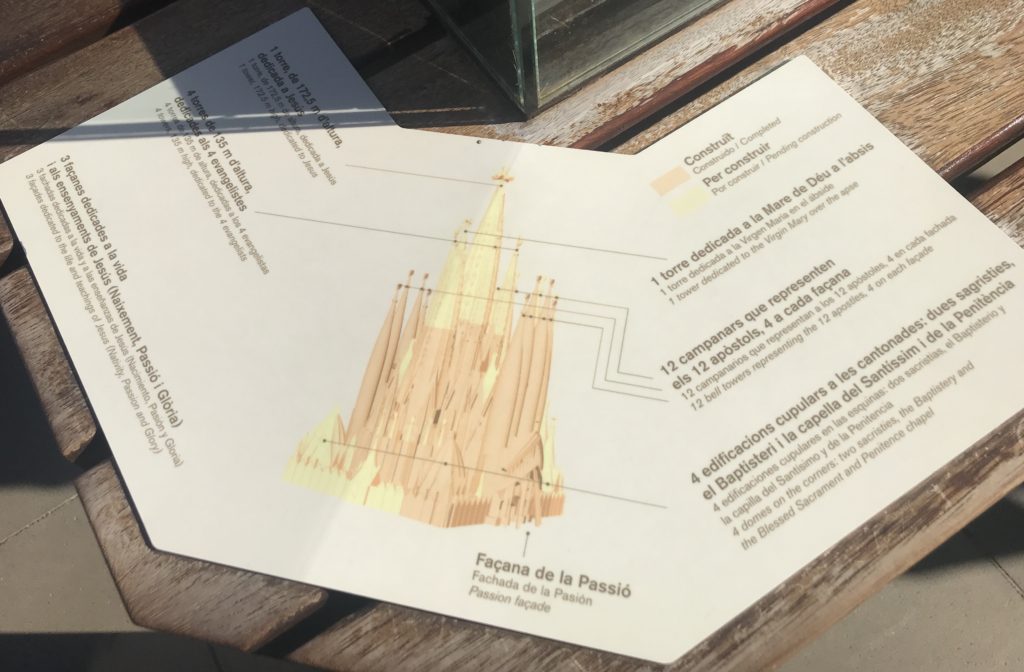
Visiting Sagrada Familia
I highly recommend purchasing tickets online through the Sagrada Familia website well in advance. The basilica is an incredibly popular attraction. Without advance tickets you’ll find yourself in a very long ticket line with no guarantee that you’ll even get tickets for that day. Tickets online range from 17€ to 32€, based on what kind of package you want. We opted for a visit to the church with audioguide. The audioguide was great as it pointed out, and explained, a lot of things about the structure of the church that I would not have noticed otherwise. Buy your tickets at least a week in advance as they do sell out quick, especially if you are looking for just the basic ticket. By purchasing a ticket, you are helping finance the construction of the church which has an annual budget of 25million €. The admission entrance is located at the Nativity façade of the basilica which currently serves as the main entrance.
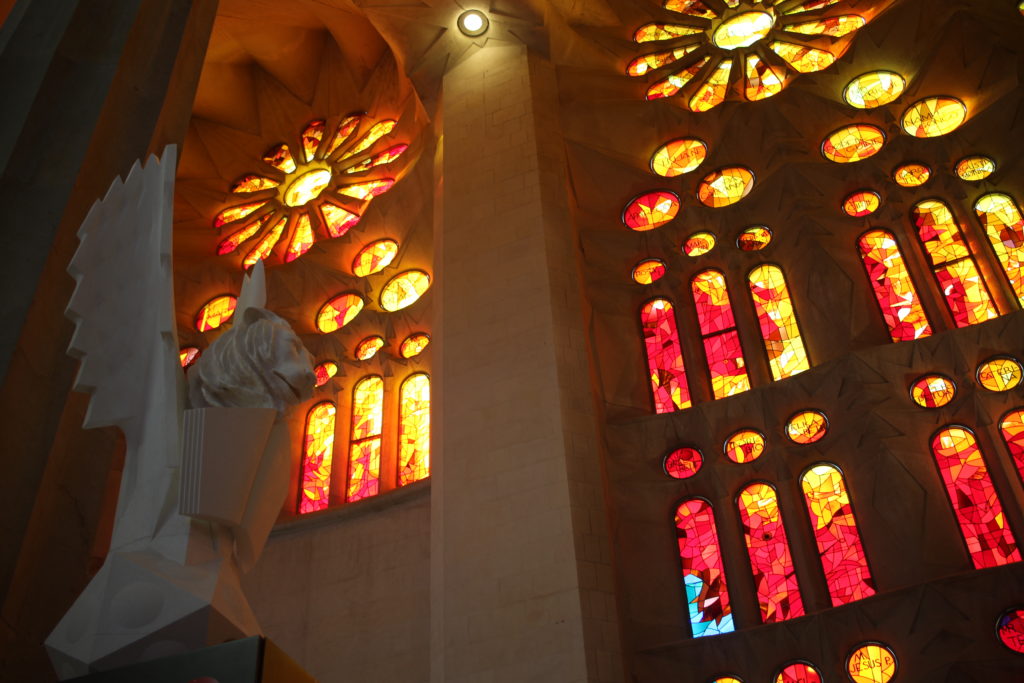
Know Before You Go
Security is tight at the basilica. Before entering you’ll have to pass through a security checkpoint where your bags will be checked and you have to pass through a metal detector. It’s very much like security at an airport. Hats are not allowed to be worn inside unless it is for health or belief related reasons. Keep in mind, it is a Catholic Church so you do have to dress appropriately. Shoulders should be covered, shorts and skirts must come to at least mid-thigh, and no see-through clothing. If you wouldn’t wear it to church service, don’t wear it to tour Sagrada Familia. The earlier hours of the day seem to attract the most people. We did our tour in the morning and even the street in front was packed with people taking photos. When we passed by again in the late afternoon there were far less people out front making it much easier to get photos.
Understanding the Design
Gaudí’s design is full of symbols and representations of Jesus’ life. To start one of the most prominent features of the basilica are the number of spires. When it is completed there will be a total of eighteen spires. Twelve smaller spires to represent the Twelve Apostles, one spire to represent the Virgin Mary, four for the four Evangelists, and the tallest representing Jesus Christ. The Basilica itself has three grand façades: on the east side the Nativity Façade, in the west the Passion Façade, and in the south the still-to-be-completed Glory Façade.
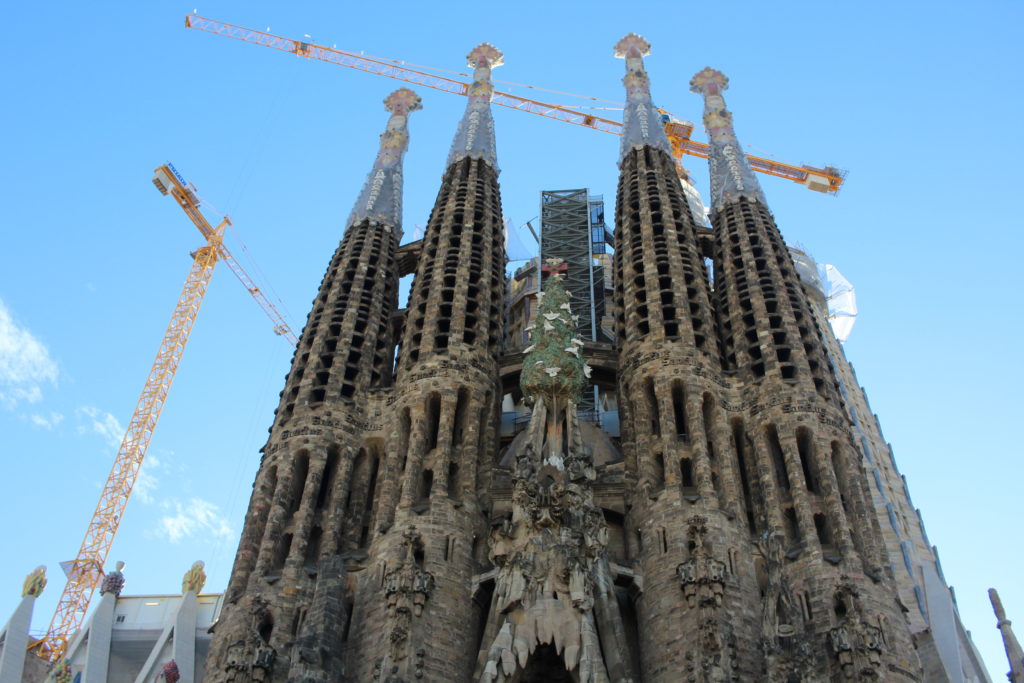
The Nativity Façade
This façade has the most visible influence from Gaudí and is dedicated to the birth of Jesus. This façade faces the rising sun, a symbol of the birth of Christ. It is incredibly decorated with images and scenes from nature which is where Gaudí drew a lot of his inspiration. It is further divided into three porticos, each representing a theological virtue: hope, charity and faith. In the charity portico you’ll find the door of Jesus with the tree of life visible above the door. You could spend a good hour here taking in every detail placed on this façade. With the many figures showing the birth of Christ to all the animals and plants, each thing is a symbol in its own manner.
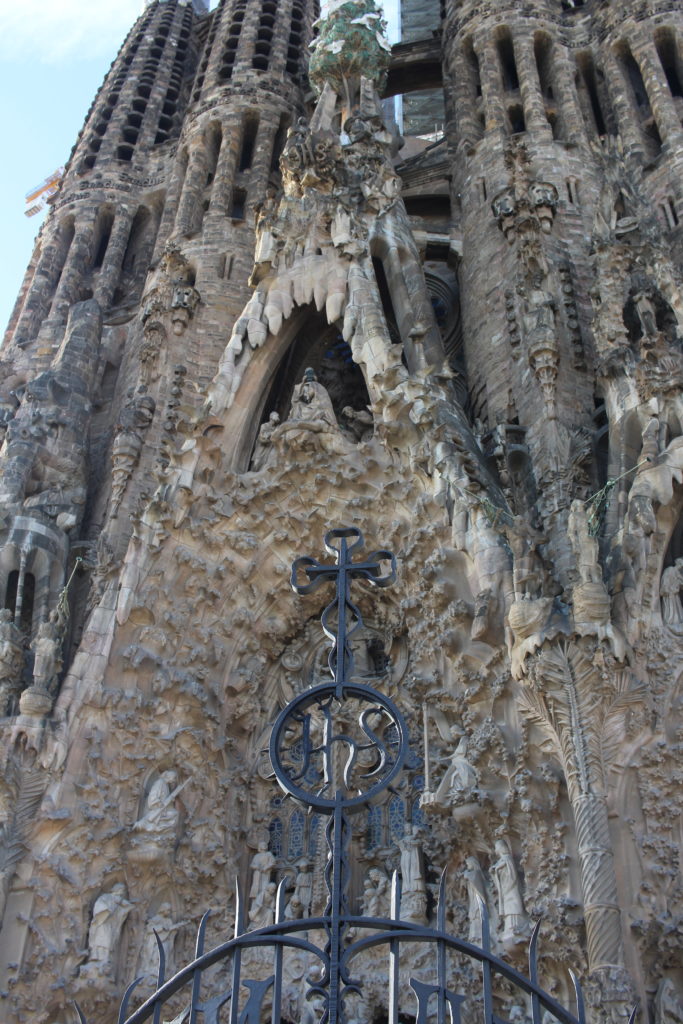
The Passion Façade
The Passion Façade greatly contrasts the highly decorated and colourful Nativity Façade. I found this façade to be the most powerful and moving. It is dramatic, yet plain and simple with bare stone carved in harsh straight lines. They are carved that way to make you think of the bones of a skeleton making it that much more haunting. Dedicated to the Passion of Christ, this façade is meant to portray the sins of man and show the suffering and brutality of Christ’s sacrifice and ultimately, the pain and suffering during his crucifixion. This façade faces the setting sun, a symbol of the death of Christ. The scenes on the façade tell the story of the final day of Christ, starting near the bottom, and work their way up to his crucifixion and resurrection at the top of the façade.
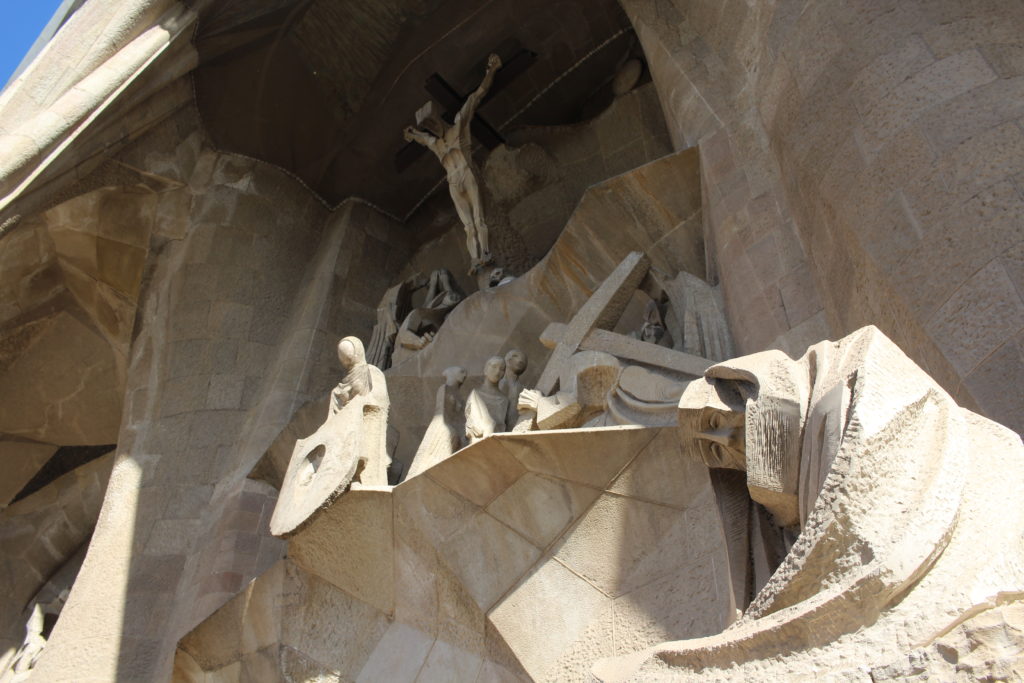
The Glory Façade
Construction is still underway for the Glory Façade but once completed it will be dedicated to the Glory of Jesus. Once completed this will serve as the main entrance to the Basilica with a large staircase crossing over Mallorca street to lead you into the main nave. The portico will have seven large columns representing the seven gifts of the Holy Spirit. At the top of these seven columns there will be representations of The Seven Virtues and at the bottom representations of The Seven Deadly Sins. There will be a total of seven doors, five for each nave with the central one featuring a triple door. These seven doors represent the Seven Sacraments. The main doors to the Glory Façade have been installed but are not yet visible. These doors feature the Lord’s Prayer in Catalan as well as the words “Give us our daily bread” inscribed in 50 different languages.
The Interior
The interior of the church is incredibly different from the outside of the church. You won’t find intricate stained glass windows featuring Saints and other figures here. The windows are designed to let light and colour into the basilica. The windows also differ in colour and detail depending on which façade they belong to. The columns inside the nave make you feel as if you’re walking through a forest. It features columns of different size and stone that branch out at the top like trees. The stone chosen for each column depends on how much weight that column must bear to support the structure.

The Basilica de la Sagrada Família makes a great stop for anyone visiting Barcelona. Between the legend behind the construction itself and the sheer detail that has gone into it, it is definitely something to marvel at. For someone like myself who is fascinated by symbolism it is easy to spend a good portion of the day here observing everything. Sagrada Família is a can’t miss in Barcelona.
I’ve been doing a lot of traveling recently and have a lot to catch up on. I’ll be a lot more active on my Instagram in the coming days as I start publishing more posts and posting more photos. You can also follow along on Facebook and Twitter!
Until next time!
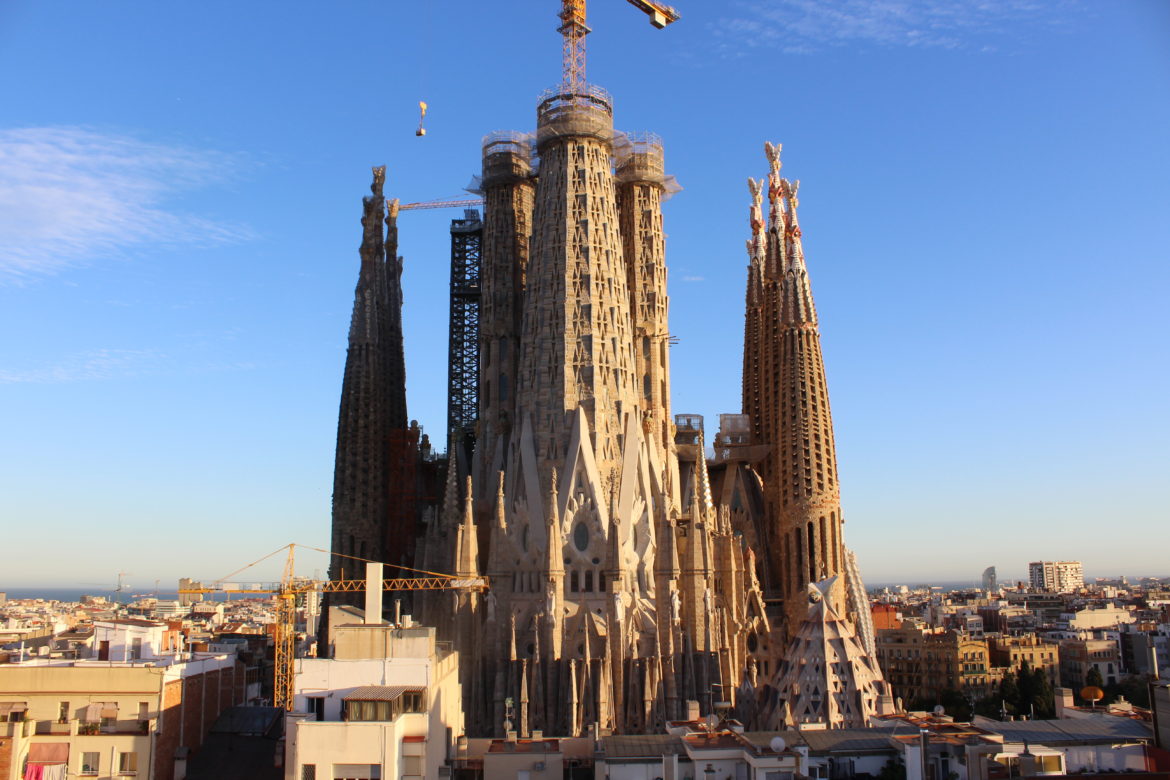
Very interesting. I learned a lot of stuff that I didn’t know about Sagrada Familia. Thank you for sharing.